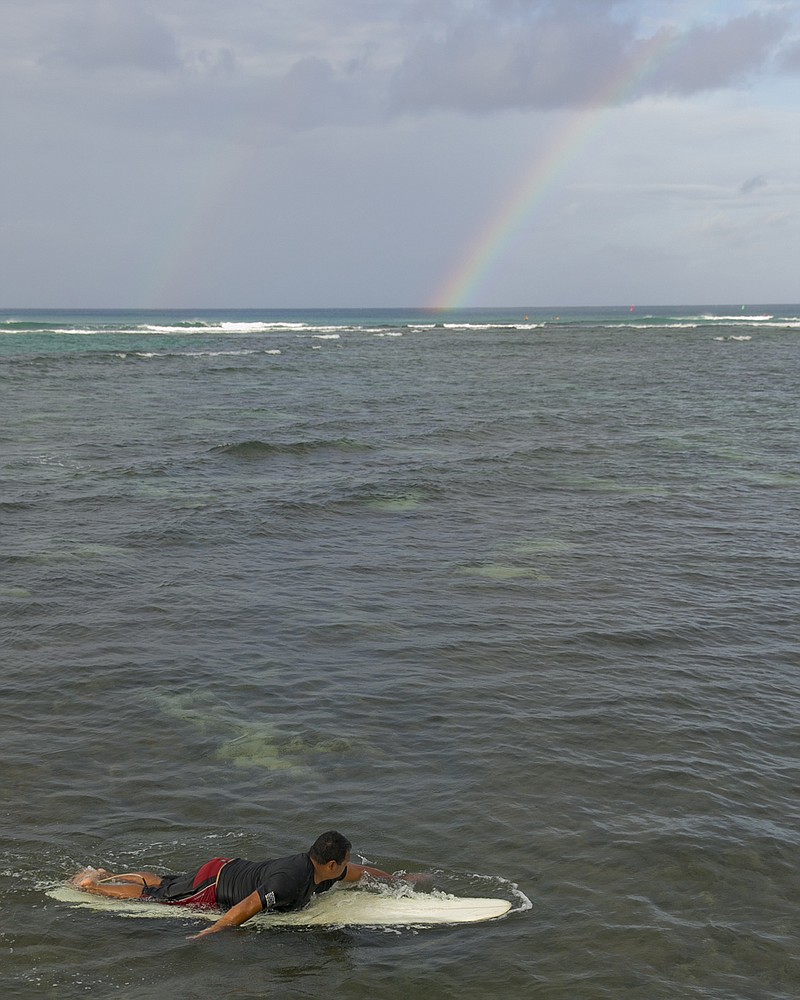HONOLULU (AP) - As the first tropical storm to hit Hawaii in 22 years passed by the islands, some coffee farmers on the Big Island began navigating flooded roads to assess damage to their crops Friday while tourists wandered the beaches of Oahu and surfers took to the waves despite driving rain and wind.
The first storm in a one-two punch heading for Hawaii clamored ashore overnight Friday as a weakened tropical storm. A second system close behind it also weakened and was on track to pass north of the islands by several hundred miles.
Tropical Storm Iselle knocked out power, caused flooding and downed trees when it crossed onto the Big Island. There have been no reports of deaths or major injuries, Gov. Neil Abercrombie said Friday.
About 21,000 homes remained without power on the Big Island where the main part of Iselle came ashore in a rural and sparsely populated region, Hawaii County Civil Defense spokesman John Drummond said.
Those staying in shelters were told to return home, while crews cleared trees from roads, county spokesman Kevin Dayton said.
The state Department of Health warned the public to stay out of floodwaters and storm water runoff across Hawaii because they are known to attract sharks as they wash possible dead animals into the ocean.
Heavy rains and wind from the storm's outer bands also hit Maui and Oahu on Friday as Iselle moved west, but south of the other islands, out to sea. Abercrombie stressed that even though the brunt of storm hit the Big Island and Maui, Kauai and Oahu need to remain vigilant.
"We won't be able to give all-clear until late this afternoon or early evening," Abercrombie said Friday.
Honolulu's lifeguard division said about a dozen surfers were riding waves Friday at a spot nicknamed "Suicides," near the popular Diamond Head crater. Lifeguards on Oahu were planning to only respond to emergency calls, avoiding regular patrols.
Back on the Big Island, coffee farmers on the southeastern side tried to get around fallen trees on flooded roads to determine any crop damage, said Randy Stevens, general manager of Kau Coffee Mill.
"It's raining so hard we're just trying to get the roads opened up so we can get to the fields," Stevens said.
The heavy rain and flooding seen in the southeastern Kau district is vastly different from the relatively drier Kona region on the Big Island's western side, where much more coffee is grown, and the storm had little impact.
"We're all buttoned up, but nothing happened," said Bruce Corker, a Kona coffee farmer.
Meanwhile, Hurricane Julio, some 900 miles behind in the Pacific, was downgraded to a Category 2 storm and packed maximum sustained winds of about 105 mph. National Weather Service officials predict it will continue to weaken on a path that should take it about 200 miles north of the island chain starting sometime Sunday morning.
If Julio stays on track, "the impacts to the islands would be minimal," Weather Service meteorologist Derek Wroe said. "We would see some large surf. ... We could see some heavy showers. That's all assuming this track holds. Otherwise, we could still see some tropical storm conditions."
There remains uncertainty given its distance from land.
"We're not out of the woods yet with Julio," Wroe said.
Iselle also had weakened, having been downgraded to a tropical storm about 50 miles from shore late Thursday, and within hours, its winds slowed to 60 mph, well below the 74 mph threshold for a hurricane.
Experts said wind shear chopping at the system and the Big Island's mountainous terrain helped weaken the storm.
Hawaii has been directly hit by hurricanes or tropical storms only three times since 1950. The last time was in 1992, when Hurricane Iniki killed six people and destroyed more than 1,400 homes in Kauai.
The state prepared for the back-to-back storms by closing government offices, schools and transit services across Hawaii. But Saturday's primary elections, including congressional and gubernatorial races, will go forward as planned.
The storms are rare in Hawaii but not unexpected in El Nino years, a change in ocean temperature that affects weather around the world.

